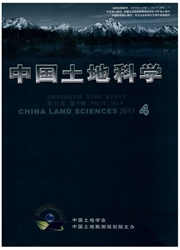

 中文摘要:
中文摘要:
研究目的:分析经济增长方式与农地非农化的关系,解释中国农地非农化规模长期高位运行原因,为制定“十二五”管理目标与政策提供参考。研究方法:统计分析,比较研究,回归分析。研究结果:(1)1990—2009年江苏省单位经济增长的土地代价水平介于20世纪60—70年代美国、日本之间;(2)经济增长主要依赖大规模固定资产投资,冶金、化工等对工业增长贡献大,制约了江苏省经济增长土地代价水平的下降;(3)“十二五”期间江苏乃至全国农地非农化规模将保持在较高水平,资源环境压力进一步加大。研究结论:有效的耕地保护策略不仅要求微观上完善资源配置机制,还必须在宏观上转变经济增长方式。
 英文摘要:
英文摘要:
The purpose of this study is to find out the impact of economic growth pattern on farmland conversion, aiming to explain the high conversion rate in the last decade and provide references for policy reform for the 12th five-year plan of China's economy. Methods of statistical analysis, comparative analysis and regression analysis were employed. The results indicated that 1 ) the average quantity of arable land loss per unit GDP growth in Jiangsu Province from 1990 to 2009 was the same level of that of the U.S. and Japan in the period of 1960s and 1970s; 2) it was constrained to reduce the loss of arable land due to the economic growth mode in Jiangsu Province, which was highly dependent on the large-scale fixed capital investment , such as metallurgy, chemical industries; 3 ) the rate of farmland conversion would keep in a high level in the next five years, which further deteriorated the burden of nature resource and environment. The paper concluded that it was at least equally important to improve land market mechanism and transform the economic growth pattern regarding arable land effective preservation in China.
 同期刊论文项目
同期刊论文项目
 同项目期刊论文
同项目期刊论文
 Integrated assessment of agricultural land use policies on nutrient pollution and sustainable develo
Integrated assessment of agricultural land use policies on nutrient pollution and sustainable develo 期刊信息
期刊信息
